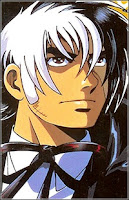 Creator: Kaori Yuki
Creator: Kaori Yuki
U.S. publisher: Viz Media
ISBN: 9781421536361
Released: October 2010
Original release: 2009
For the Kaori Yuki Manga Moveable Feast, I decided to take a look at Overture, the first volume in Grand Guignol Orchestra, the most recent of Kaori Yuki’s manga series to be released in English. The first volume of Grand Guignol Orchestra was originally published in Japan in 2009. Overture was subsequently released in English in 2010 by Viz Media under its Shojo Beat imprint. Although Yuki has had several of her works licensed in English, the only other manga of hers that I have read is Godchild. It took a while for that series to grow on me, but I ultimately enjoyed its dark, Gothic horror. However, I never quite got around to pursuing more of Yuki’s manga until Grand Guignol Orchestra was released. What particularly appealed to me about Grand Guignol Orchestra and convinced me to pick it up was its fantastical use of music.
As members of the Queen’s unofficial Grand Orchestra, Lucille, Kohaku, and Gwindel tour the countryside, journeying to places that the official orchestra wouldn’t dare. With the outbreak of the virus that causes Galatea Syndrome—transforming people into violent, doll-like zombies known as guignols—traveling is a dangerous endeavor. But it is the responsibility of the Grand Orchestra, even the unofficial one, to seek out and destroy the guignols and investigate the often bizarre circumstances surrounding the spread of the disease. The highly trained and capable musicians use their musical talents and a bit of combat training to annihilate the threat to the general population. Unfortunately, their people skills can be somewhat lacking and their help isn’t always welcomed by the people they are trying to aid. Guignols aren’t the only ones who pose a danger to the orchestra and its members.
Yuki’s artwork is one of the highlights of Grand Guignol Orchestra. She describes the series’ setting as taking place in the Middle Ages with a French flair to it (and with some very obvious anachronistic deviations.) The attention given to the costume designs with all their layers and frills is particularly marvelous. The guignols themselves also have a great design and are suitably creepy with their haunted eyes and cracking skin. In general, the artwork creates an excellent atmosphere for the Gothic tale. Unfortunately, it often seems at odds with the humor that Yuki attempts to introduce into the series. Although somewhat entertaining and a relief from the wonderfully melodramatic plot, the more comedic aspects of the series don’t seem to mesh quite yet with its darker elements. At times Grand Guignol Orchestra is deadly serious while at others it’s purposely ridiculous. The result can be awkward.
Considering how many elements there are in Grand Guignol Orchestra that I actually really like, I am very surprised that I didn’t enjoy the first volume more. I love the destructive and redemptive power granted to music in the series and get a huge kick out of the ability to take out zombies with a tuning fork. I also like the gender-bending aspects of the story and characters. Lucille, much to his dismay, is mistaken for a woman more often than not, but is generally happy to use this to his advantage. He’s not the only character who plays with gender, either. Overture is very much an introductory volume. Although the deliciously tragic pasts of the musicians have been hinted at, very little is actually known about them at this point and will be revealed later on in the series. But if I had to judge by the first volume alone, I would have to say that I appreciate and enjoy Grand Guignol Orchestra more in concept than I do in execution.





